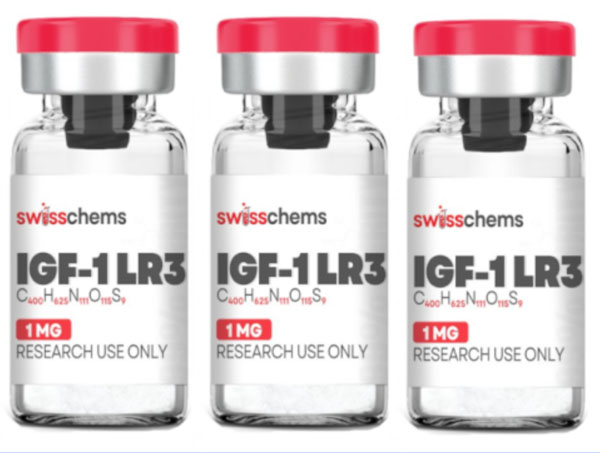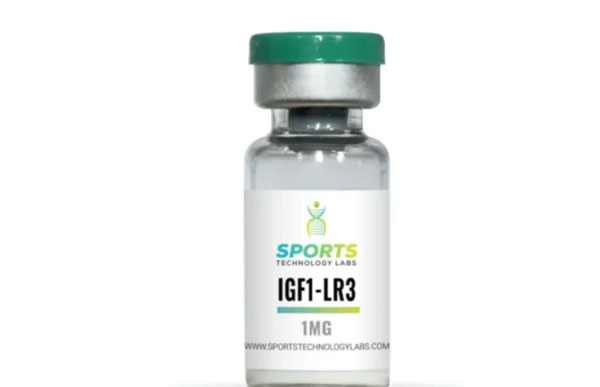IGF-1 LR3 Review: Dosage, Benefits, Side Effects and More
By Space Coast Daily // May 13, 2024

IGF-1 LR3 peptide offers an alternative method for gaining lean muscle and increasing muscle mass. The synthetic peptide is 3x more potent compared to standard Insulin-like Growth Factor 1 (IGF-1). IGF-1 LR3 peptide redefines muscle definition and body tone as well as delivers increased strength.
For this reason, the peptide has evolved into a popular muscle growth supplement. Interested? Learn more about IGF-1 LR3 peptide in the complete review:
What is IGF-1 LR3?
Note: Click Here Now to pick up IGF1 LR-3 from our #1 rated source. Insulin-like Growth Factor 1 LR3 is a new and improved version of IGF-1. The modified version is engineered to replicate the effects of Insulin-like Growth Factor 1.1 Notwithstanding, IGF-1 LR3 is longer and more stable thus making the peptide 3x more potent. For this reason, the peptide has transformed into a popular muscle growth supplement for bodybuilders and weightlifters. IGF-1 LR3 peptide is designed to produce new lean muscle and increase muscle mass.2 The synthetic form features a lower binding affinity with IGF-binding proteins.
As a result, IGF-1 LR3is not as powerful as HGH muscle growth supplements yet also not nearly as dangerous. Unfortunately, HGH supplements and other performance-enhancing substances generally produce serious side effects. Be that as it may, peptides like IGF-1 LR3 do not disrupt hormones and/or feature the same potential long-term health risks. Thus, many people believe that peptides are a better alternative to stacking on new muscle and bulking up. IGF-1 LR3 peptide features many other health benefits (more information, below).
Nevertheless, fitness and medical experts are still learning more about the compound as it continues to undergo research in clinical studies. The U.S. Food & Drug Administration (FDA) has approved recombinant IGF-1 for use. Despite this, the modified version is still under investigation since it was recently introduced to the market. Consequently, caution is advised when buying peptides because not all websites are trustworthy or legit.
How Does It Work?
Insulin-like Growth Factor 1 LR3 is classified as a polypeptide. The modified form of Insulin-like Growth Factor 1 (IGF-1) features a unique chemical structure.3 IGF-1 LR3 is designed to replicate a natural insulin hormone that is produced in the liver and pancreas. From there, the peptide stimulates and regulates a variety of biological and hormonal processes critical to personal health.
The long-version of Insulin-like Growth Factor 1 (IGF-1) is known as a human recombinant protein. In other words, recombinant proteins are encoded with DNA that exists inside an expression vector.4 Often, these proteins are manipulated from the native version to repair damaged tissue or stimulate new growth. Thus, IGF-1 LR3 influences muscle growth by modifying gene sequences that have become defective with age. Secondly, the chemical structure of the long version of IGF-1 has been adjusted to serve as an agonist of the receptor. Therefore, the peptide features a low affinity for insulin-like growth factor-binding proteins (IGFBPs) that may disrupt or impair other hormones.5 Consequently, many users have noticed few side effects compared to the horrors experienced with steroids or HGH supplements. Nevertheless, IGF-1 LR3 promotes muscle growth by stimulating the release of IGF-1. Moreover, the peptide encourages the release of other growth hormones including testosterone and natural HGH.6 Third, IGF-1 LR3 peptide is considered 3x stronger compared to standard IGF-1 generating lean muscle.
The modified, long-form version features a significantly longer half-life (20 – 30 hours) compared to regular IGF-1.7 Accordingly, IGF-1 LR3 remains longer in the body as it continues to produce results. Lastly, research (more details, below) reveals that IGF-1 LR3 peptide has wide-reaching capabilities in the body. For example, the peptide has been found to repair and stimulate tissue, bone, cartilage, nerves, and several organs.
Benefits of IGF-1 LR3 Peptide
Note: Click Here Now to pick up IGF1 LR-3 from our #1 rated source. What are the benefits of using IGF-1 LR3 peptide? For starters, the peptide is one of the best methods for building lean muscle, increasing mass, and getting stronger.
The peptide was deliberately modified to encourage new growth and reverse the signs of aging. More importantly, IGF-1 LR3 does not appear to present the same unwanted side effects as anabolic steroids or HGH supplements. Thus, IGF-1 LR3 helps restore critical growth hormones that become less abundant with age. It can make a tremendous difference for men and women who want to look younger and feel stronger. The reported benefits of Insulin-like Growth Factor 1 LR3 include:
- Burns Fat (Weight Loss)
- Rapid Muscle Growth
- Improved Muscle Mass
- Increased Strength & Energy
- Better Sleep
- Improved Metabolism
- Improved Insulin Sensitivity
There is evidence that IGF-1 LR3 may improve sex drive and performance in the bedroom. However, most of these circumstances were reported in user reviews of the peptide and have not been verified in clinical studies. Nevertheless, there are indications that IGF-1 LR3 features many other potential benefits essential to cognitive function and mental health. IGF-1 LR3 peptide is popular with bodybuilders because it promotes muscle growth and quick recovery after a long, hard workout. The peptide stimulates new muscle growth yet avoids developing water retention or other issues related to anabolic steroids. Still, make sure to only purchase from a website that sells dependable, high-quality peptides that have been third-party tested for purity.

How to Use
Insulin-like Growth Factor 1 LR3 was modified to create a more potent, longer-lasting form of IGF-1. Therefore, the synthetic version produces many of the same effects as standard IGF-1 yet with a longer half-life (20 – 30 hours). For this reason, there is no need to use IGF-1 LR3 more than once per day. The long-form version was created to stimulate muscle growth and increase muscle mass yet over a duration of time. Consequently, new users should first speak with a physician about any questions or concerns they might have using the substance. It’s difficult to predict how the peptide may interfere with other prescribed medications or preexisting health conditions. Secondly, begin with a lower dosage (more details, below) to avoid unwanted side effects. In general, most new users start with a lower dose and monitor side effects over the first several weeks of use. Then, if the body appears to adjust well to the new compound, may consider a higher dosage.
Third, users should never exceed using IGF-1 LR3 for longer than the recommended cycle length. Generally, most fitness experts advise using a cycle that lasts between 4 – 8 weeks. Fourth, IGF-1 LR3 peptide is available for sale in various forms including powder, liquid, tablets, and capsules. There are advantages and disadvantages to each type of peptide depending on fitness goals or personal tastes.
For example, it takes a little more time and effort to prepare liquid and powder peptides for subcutaneous injections. Therefore, users must follow proper storage directions and any other recommended guidelines provided by the manufacturer / online supplier. Lastly, IGF-1 LR3 builds lean muscle and improves strength and endurance but only for those who are serious about redefining their bodies.
Thus, the peptide functions best combined with regular exercise and a healthy nutrition plan.
IGF-1 LR3 Dosage
Unfortunately, standard guidelines do not exist. Insulin-like Growth Factor 1 LR3 was recently developed and lacks clinical oversight. For this reason, the peptide has not yet been approved by the FDA. As such, the substance is only available for research and experimental purposes. In the past, those who have used IGF-1 LR3 and reported about the experience suggest a dosage between 20 – 50 mcg. You’ll find that the number jumps around depending on several factors including age, weight, and desired fitness goals. Furthermore, new users need to take into account that the body is getting adjusted to a new substance and begin with a lower dosage. IGF-1 LR3 is potent and produces results for an extended period.
Thus, the peptide does not need to be injected each day to produce results. In general, most people aim for a cycle that lasts between 4 – 6 weeks. People should never attempt to exceed 8 weeks regardless of experience using peptides. In the past, side effects were most common in people misusing the substance or taking longer than suggested. You’ll find that using IGF-1 LR3 shortly before exercise is the best time to maximize results. Finally, IGF-1 LR3 is frequently combined with other peptides and SARMs for quicker, improved results.
IGF-1 LR3 Side Effects
The side effects associated with IGF-1 LR3 are minimal based on user reviews and limited clinical studies.
The most common side effects reported include:
- Nausea
- Fatigue
- Headaches
- Dizziness
The patterns of headaches or dizziness may be related to low blood sugar. Often, people using a new substance monitor their vitals within the first few weeks to determine how it affects the body. IGF-1 LR3 features a long half-life (20 – 30 hours) which makes it unnecessary to use more than once per day. Previously, the most damaging side effects related to the peptide have been because of misuse. For this reason, always make sure not to exceed recommended dosage guidelines and follow other safety measures. Those who use injections may experience some pain and discomfort at the site of injection. Fortunately, the symptoms are not usually extreme or last for an extended period. Notwithstanding, those using injections must take other precautions to avoid infections or other health risks. Lastly, water retention and a bloated stomach (“bubble gut”) have been documented in rare circumstances. Bubble gut almost always occurs when individuals use the peptide in high doses or extended periods (60+ days). Unfortunately, IGF-1 LR3 has not been reviewed extensively in clinical studies. Thus, most of the information is based on limited findings and what is already known regarding the peptide through first-hand accounts.
IGF-1 LR3 Peptide Results
Insulin-like Growth Factor 1 LR3 was recently introduced as an alternative to HGH supplements. As such, the synthetic peptide is designed to produce lean muscle and increase muscle mass but without the same harmful side effects. Thus, IGF-1 LR3 is not quite as potent as HGH supplements yet offers many of the same benefits. In the past, researchers have discovered that the peptide stimulates new lean muscle and other forms of growth. 8 Moreover, studies have determined that IGF-1 LR3 is far more potent and effective at producing lean muscle compared to standard IGF-1.9 The short half-life of regular IGF-1 (1 – 4 hours) makes injecting the synthetic substitute unreliable. However, the modified version (IGF-1 LR3) is 3x more potent compared to the standard form in animal models.10 More importantly, the peptide does not produce the same damaging effects as anabolic steroids and other performance-enhancing supplements.11 Previously, research has also linked the peptide to protein / RNA synthesis, cellular production, and glucose transport. Be that as it may, several questions continue to exist since the peptide has not been extensively studied. IGF-1 LR3 is not regulated by the FDA and very few clinical studies have been published. Therefore, most information and success stories are based on user experiences that have been posted online. Nevertheless, IGF-1 LR3 features incredible potential and efforts should be made to promote future research. The peptide is well-received by bodybuilders and endorsed by several fitness experts.
Conclusion
Unfortunately, research shows that men and women experience the development of fewer hormones with age. Therefore, finding a safe and healthy way to promote new growth is essential to reversing these awful trends. Insulin-like Growth Factor 1 LR3 peptide reverses the effects of aging by stimulating new growth. The peptide is far more powerful and long-lasting compared to standard Insulin-like Growth Factor 1 (IGF-1). As a result, IGF-1 LR3 peptide has become popular with men and women who want to get stronger and look ripped. IGF-1 LR3 features many of the same benefits as other muscle growth supplements yet without the same dangerous side effects. Be that as it may, the peptide was recently developed and remains under investigation. Thus, make sure to only purchase high-quality peptides from a dependable online supplier.
Note: Click Here Now to pick up IGF1 LR-3 from our #1 rated source.
References
- Bailes J, Soloviev M. Insulin-Like Growth Factor-1 (IGF-1) and Its Monitoring in Medical Diagnostic and in Sports. Biomolecules. 2021 Feb 4;11(2):217. doi: 10.3390/biom11020217. PMID: 33557137; PMCID: PMC7913862.
- Philippou A, Barton ER. Optimizing IGF-I for skeletal muscle therapeutics. Growth Horm IGF Res. 2014 Oct;24(5):157-63. doi: 10.1016/j.ghir.2014.06.003. Epub 2014 Jun 19. PMID: 25002025; PMCID: PMC4665094.
- Assefa B, Mahmoud AM, Pfeiffer AFH, Birkenfeld AL, Spranger J, Arafat AM. Insulin-Like Growth Factor (IGF) Binding Protein-2, Independently of IGF-1, Induces GLUT-4 Translocation and Glucose Uptake in 3T3-L1 Adipocytes. Oxid Med Cell Longev. 2017;2017:3035184. doi: 10.1155/2017/3035184. Epub 2017 Dec 20. PMID: 29422987; PMCID: PMC5750484.
- Gou P, Cheng X, Leng J, Su N. A Real-World Study of Recombinant Human Growth Hormone in the Treatment of Idiopathic Short Stature and Growth Hormone Deficiency. Ther Clin Risk Manag. 2022 Mar 16;18:113-124. doi: 10.2147/TCRM.S363564. PMID: 35342293; PMCID: PMC8943615.
- Ding H, Wu T. Insulin-Like Growth Factor Binding Proteins in Autoimmune Diseases. Front Endocrinol (Lausanne). 2018 Aug 30;9:499. doi: 10.3389/fendo.2018.00499. PMID: 30214426; PMCID: PMC6125368.
- Laron Z. Insulin-like growth factor 1 (IGF-1): a growth hormone. Mol Pathol. 2001 Oct;54(5):311-6. doi: 10.1136/mp.54.5.311. PMID: 11577173; PMCID: PMC1187088.
- von der Thüsen JH, Borensztajn KS, Moimas S, van Heiningen S, Teeling P, van Berkel TJ, Biessen EA. IGF-1 has plaque-stabilizing effects in atherosclerosis by altering vascular smooth muscle cell phenotype. Am J Pathol. 2011 Feb;178(2):924-34. doi: 10.1016/j.ajpath.2010.10.007. PMID: 21281823; PMCID: PMC3069834.
- Serra C, Bhasin S, Tangherlini F, Barton ER, Ganno M, Zhang A, Shansky J, Vandenburgh HH, Travison TG, Jasuja R, Morris C. The role of GH and IGF-I in mediating anabolic effects of testosterone on androgen-responsive muscle. Endocrinology. 2011 Jan;152(1):193-206. doi: 10.1210/en.2010-0802. Epub 2010 Nov 17. PMID: 21084444; PMCID: PMC3033058.
- Madathil SK, Saatman KE. IGF-1/IGF-R Signaling in Traumatic Brain Injury: Impact on Cell Survival, Neurogenesis, and Behavioral Outcome. In: Kobeissy FH, editor. Brain Neurotrauma: Molecular, Neuropsychological, and Rehabilitation Aspects. Boca Raton (FL): CRC Press/Taylor & Francis; 2015. Chapter 7. PMID: 26269893.
- Tomas FM, Knowles SE, Owens PC, Chandler CS, Francis GL, Read LC, Ballard FJ. Insulin-like growth factor-I (IGF-I) and especially IGF-I variants are anabolic in dexamethasone-treated rats. Biochem J. 1992 Feb 15;282 ( Pt 1)(Pt 1):91-7. doi: 10.1042/bj2820091. PMID: 1371669; PMCID: PMC1130894.
- Tahimic CG, Wang Y, Bikle DD. Anabolic effects of IGF-1 signaling on the skeleton. Front Endocrinol (Lausanne). 2013 Feb 4;4:6. doi: 10.3389/fendo.2013.00006. PMID: 23382729; PMCID: PMC3563099.











